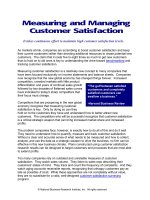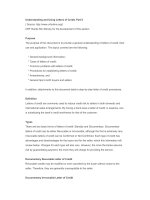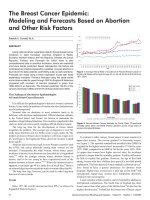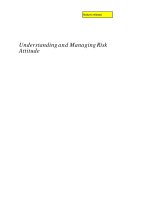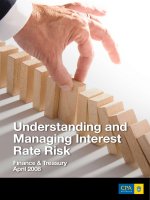Understanding and Managing Risk Attitude potx
Bạn đang xem bản rút gọn của tài liệu. Xem và tải ngay bản đầy đủ của tài liệu tại đây (3.31 MB, 191 trang )
Understanding and Managing Risk
Attitude
Nature release
Managers looking to move to higher levels of risk management maturity in their
organisations
willfind much insight andguidance in this innovative book.
Prof Graham M. Winch, Centre for Research in the Management of Projects,
Manchester Business School
This book provides a pivotal insight into the complexities of human behaviour,
psychological influences and subconscious preferences that determine how people
initially respond to significant uncertainty
and creates a road map to change risk
attitude
ifit is both necessary and desirable.
Carl West, Operations Auditor, British Waterways
This book highlights how riskattitude factors influence the human psyche, and carefully
explains the impacts. Organisations seeking to dramatically improve the effectiveness of
their risk management process will want to use this book's insights.
Craig Peterson, President, PMI Risk Management SIG
This book has prompted me to think more deeply
as
a change director.
Jon Bassett, Director of Implementation,
AXA
Life
UK
Understanding
and
Managing
Risk
Attitude
DAVID HILLSON
and
RUTH MURRAY
-
WEBSTER
GOWER
O
David Hillson and Ruth Murray
-
Webster 2005
AU
rights reserved. No part of this publication may be reproduced, stored in a retrieval
system, or transmitted in any form or by any means electronic, mechanical,
photocopying, recording or otherwise without the prior permission of the publisher.
Published by
Gower Publishing Limited
Gower House
Croft Road
Aldershot
Hants
Gull 3HR
England
Gower Publishing Company
Suite 420
101 Cherry Street
Burlington,
VT
05401
-
4405
USA
David
Hillson and Ruth Murray
-
Webster have asserted their right under the
Copyright, Designs and Patents Act 1988 to be identified as the authors of this work.
British Library Cataloguing in Publication Data
Hillson, David, 1955
-
Understanding and managing risk attitude
1. Risk management
I.
Title 11. Murray
-
Webster, Ruth
658.1'55
ISBN
0 566 08627 1
Library of Congress Cataloging
-
in
-
Publication Data
Hillson, David, 1955
-
Understanding and managing risk attitude
I
by David Hillson and Ruth Murray
-
Webster.
p. cm.
Includes bibliographical references and index
ISBN: 0-566
-
08627
-
1
1. Risk management. I. Murray-Webster, Ruth.
11. Title.
HD61
.H48 2005
658.15'5 dc22
Typeset by IMLTypographers, Birkenhead, Merseyside and
Printed in Great Britain by MPG Books Ltd. Bodmin,
Cornwall
Contents
List of Figures
List of Tables
Foreword
Preface
Acknowledgements
PART
1:
THE
PROBLEM
1
Risk Management Status Quo
-
Efficient but not
Effective?
The risk environment
What is risk?
What is attitude?
Risk management in today's business
Is risk management effective?
Purpose and structure of this book
2
The Importance of Human Factors
in
Risk Management
Why human factors matter to risk management
Risk management and the individual
Risk management and the group
Diagnosis is not the same as treatment
PART
2
:
UNDERSTANDING RISK ATTITUDES
3
General Principles of Risk Attitudes
The risk attitude spectrum
Basic risk attitudes
Situational influences on preferred risk attitude
Internal influences on preferred risk attitude
Conclusion and summary
4
Individual Risk Attitudes and Heuristics
Covert factors influencing individual risk attitude
The availability heuristic
The representativeness heuristic
ix
xi
xiii
xv
xvii
vi
U
N
D
E
R
S
T
A
N
D
I
N
G
A
N
D
M
A
N
A
G
I
N
G
R
I
S
K
A
TT
I
T
U
D
E
The anchoring and adjustment heuristic
The confirmation trap
Understanding individual heuristics
5
Group Risk Attitudes and Heuristics
Understanding group risk culture
The groupthink heuristic
The Moses Factor
The cultural conformity heuristic
The risky shift and cautious shift heuristics
The influence of national culture
Modifying group risk culture
PART
3
:
UNDERSTANDING EMOTIONAL LITERACY
6
Emotion
-
Definition and Relevance
Emotion in the workplace
The history of emotional intelligence
From emotional intelligence to emotional literacy
Emotional literacy and risk management
Conclusion
7
Emotional Literacy for Individuals
Transactional Analysis and emotional literacy
Open loop system
A
mind
-
set of choice
Component parts of individual emotional literacy
Stages of individual emotional development
8
Emotional Literacy for Groups
Component parts of group emotional literacy
The role of leadership
Going forward
PART
4
:
IMPLEMENTATION ISSUES
9
Applying Emotional Literacy to RiskAttitudes
Emotionally literate management of risk attitudes
Making the change
Summary and first steps
CONTENTS
~ii
10
Final
Thoughts
and
the
Way
Ahead
Simple but difficult
Difficulties
in
understanding
risk
attitude
Difficulties
in
managing risk attitude
Too
hard?
Future developments
Conclusion
Appendix
:
Emotional
IntelUgencelLiteracy
Tooh
161
Bibliography
and
Further
Reading
167
Index
179
List
of
Figures
Efficiency, effectiveness and efficacy (from Bull, 2005)
Hierarchies of membership and influence
Typical risk management process (based on
APM, 2004)
Effect of corporate risk attitude on risk management resourcing
Attitude, behaviour and consequences
Behaviour in neutral or positive environments
Behaviour in hostile environments
Behaviour in uncertain environments
Spectrum of risk attitudes
Situational influences on risk attitude
The availability heuristic
The representativeness heuristic
The anchoring and adjustment heuristic
The confirmation trap
Group heuristics possible interrelationships
Risky shift and cautious shift heuristics
Correlating power distance index (PDI) and uncertainty avoidance
index
(UAI)
(from Hofstede, 2001)
Link between the psychological and physiological effects of emotion
Descartes' six passions
Transactional Analysis: the rational adult gets data from three sources
Interplay of Transactional Analysis life positions
A depiction of the Triune Brain (adapted from Paul
MacLean)
The need for awareness of self and others
The importance of regard for self and others
Achieving appropriate behavioural flexibility
Emotional expression and self
-
control
Adapted from the
Luft and Ingham Johari Window
Potential positive outcomes of conflict
Stages in emotional development (adapted from
Steiner)
Stages in group development (after Tuckman)
PESTLE analysis
Spectrum of risk attitudes
Default initial risk attitude
Situational initial risk attitude
Self
-
awareness and decision
-
making
X
UNDERSTANDING AND MANAGING RISK ATTITUDE
9.5
Applying
emotional
literacy
to change
risk
attitude
148
10.1
Human
factors
as
a
CSF
for
effective
risk
management
152
List
of
Tables
Critical Success Factors for effective risk management
Influence of individual risk attitudes on risk management process
Influence of organizational risk attitudes on strategic decisions
UAI
and
PDI
data
by
countrylregion (from Hofstede,
1982)
Gardner's seven intelligences
Component diagnostic elements of emotional literacy for individuals
Explaining the
Johari Window (from Luft and Ingham,
1955)
Behaviour in conflict
Relevant diagnostic elements of emotional literacy for groups
Managing risk attitudes
Foreword
We all live in a world full of risk, and on a daily basis we can either choose to take a
decision where the outcome is uncertain, or choose not to. Faced with innumerable
risks, most people have developed habits and strategies for dealing with the
uncertainty in such a way that their lives 'free
-
flow' most of the time. It is only in the
presence of an extraordinaryriskthat people are usually conscious of the need to make
a choice.
The management of these extraordinary uncertain situations has become a
discipline in its own right over the past decades, particularly in a business context, but
increasingly also in a social setting. As a result many aspects of risk management are
well defined, tried, tested and trusted
-
though not all.
This book addresses one facet of risk management that is not well understood,
namely risk attitudes. Our motivation has been to shed light on an area that on the one
hand is seen as rational and logical, but on the other involves the deepest workings of
the human brain. We aim to share with our readers our fascination with the human
influence on decision
-
making in risky situations.
Our intention is to provide a book that is informative and thought
-
provoking, yet
practical in nature.
Working to
understand
risk attitudes is a worthwhile exercise on its
own, but it is infinitely more valuable when combined with practical ways to
manage
those risk attitudes so that they support achievement of objectives.
Many readers will want to learn how to understand and manage risk attitudes so
that they can apply the learning to risky business situations, for example those
associated with safety risk, project and programme risk, financial risk and so on. The
book
will
certainly help
with
these areas. Even more importantly though, we hope that
business readers will engage with the text at a personal level and learn more about
understanding and managing their own risk attitudes in life situations outside the
workplace.
It is our expectation that those readers who apply what we have written to their
professional lives
will
benefit through deliberately understanding and managing their
risk attitudes. Beyond that, however, it is our hope that many will reflect on the
relevance of these issues to all aspects of their personal lives, and try applying the
X~V
UNDERSTANDING AND MANAGING RISK ATTITUDE
guidance we have offered. This broader approach will undoubtedly bring greater
benefits to those prepared to take a more holistic view.
DAVID
HILLSON
RUTH MURRAY-WEBSTER
Preface
Risk management is recognized as an essential contributor to business and project
success, since it focuses on addressing uncertainties in a proactive manner in order to
minimize threats, maximize opportunities and optimize achievement of objectives.
There is wide convergence and international consensus on the necessary elements for
a risk management process, and this is supported by a growing range of capable tools
and techniques, an accepted body of knowledge, an academic and research base, and
wide experience of practical implementation across many industries.
Despite this vision, in practice risk management often fails to meet expectations, as
demonstrated by the continued history of business and project failures. Foreseeable
threats materialize into problems and crises, and achievable opportunities are missed
leading to lost benefits. Clearly the mere existence of accepted principles, well
-
defined
processes and widespread practice is not sufficient to guarantee success. Some other
essential ingredient is missing.
The most significant Critical Success Factor for effective risk management is the
one most often lacking: an appropriate and mature risk culture. Research and
experience both indicate that the attitude of individuals and organizations has a
significant influence on whether risk management delivers what it promises. Risk
management is undertaken by people acting individually and in various groups. The
human element introduces an additional layer of complexity into the risk process,
with a multitude of influences both explicit and covert. These lead to adoption of risk
attitudes which affect every aspect of risk management. Risk attitudes exist at
individual, group, corporate and national levels, and can be assessed and described
with some degree of accuracy, allowing sources of bias to be diagnosed, exposing their
influence on the risk process.
But diagnosis is different from cure. Where the risk attitude currently adopted by
an individual or group is not conducive to effective risk management, action may be
required to modify that attitude. Recent advances in the field of emotional intelligence
and emotional literacy provide a means by which attitudinal change can be promoted
and managed, for both individuals and organizations.
This book brings together leading
-
edge thinking on risk attitudes and emotional
literacy to guide those wishing to move beyond mere implementation of a risk process
and towards a people
-
centred approach for risk management. It offers a unique
xvi
U
N
D
E
R
S
T
A
N
D
I
N
G
A
N
D
M
A
N
A
G
I
N
G
R
I
S
K
A
TT
I
T
U
D
E
framework for understanding and managing those human elements which are
essential for effective risk management. The combination generates powerful insights
into how the application of emotional literacy to risk psychology can deliver
significant benefits to every business
seeking to manage uncertainty and its effects.
Following the thesis offered here requires no prior knowledge of emotional
literacy, since this is a relatively new field, neither is understanding of risk attitudes or
psychology assumed. However, the reader should be familiar with the purpose and
basic processes of risk management
-
such knowledge is readily available and there
are many books already published on this subject.
Instead, the main aim of this book is to provide a thought
-
provoking but usable
reference for risk practitioners, enabling them to consider and manage the impacts of
the human dimension on risk management. This will allow risk professionals to
diagnose practically real situations and develop strategies for good practice, as well as
minimising the impact of situations where current risk attitudes may be counter
-
productive.
Anyone involved with implementing risk management will benefit from this book,
including risk practitioners, senior managers and directors responsible for corporate
governance, project managers and their teams. It will also be of interest to human
resource professionals and others interested in organizational or behavioural
psychology, as well as students, researchers and practitioners in the field of emotional
literacy, although the approach is pragmatic rather than theoretical or research-based.
Indeed anyone whose interests include both the effective management of risk and the
complexity of human behaviour will find much of value here, covering each of these
two fascinating topics, but more particularly dealing with their interaction. If the goal
is both to understand and to manage risk attitude, this book points the way.
DAVID
HILLSON
RUTH MURRAY
-
WEBSTER
Acknowledgements
'Two are better than one because they have a good reward for their toil
.
.
.
A
threefold cord is not quickly broken':
King Solomon
(970
-
928
BC).
When we decided to write this book together it was based on mutual respect and
appreciation, both professional and personal. Having completed the task we are
pleased to acknowledge the privilege of working with each other (and we are still
friends!). Each has learned from the other's area of expertise, producing a natural
synergy where the whole book is greater than the sum of our individual contributions.
More interesting for the topic has been our experience as two individuals of
understanding our risk attitudes better and developing improved emotional literacy
through the writing process. And as a minimal working group of two, we have
demonstrated that the principles outlined in this book work in practice, and we value
the learning experience and personal development.
Many people have contributed to our thinking and experience as reflected in this
book
-
too many to name individually. We are grateful to professional colleagues,
clients, mentors and even competitors, many of whom have added to our
understanding of how to manage risk attitudes using the techniques of emotional
literacy. Some have shown us how it should be done, and we have learned how not to
do it from others. Where specific ideas have been derived from elsewhere we have
attempted to give full acknowledgement, but we retain responsibility (and apologize)
for any errors or oversights in our work.
Few situations contain more risk or demand more emotional literacy than the
home, and we pay particular tribute to our spouses and children who have displayed
patience and grace while we thought, argued and wrote. They have also taught us
valuable lessons with broader application than the business environment, and made
us who we are. Much of the content of this book would not have been written without
the faithful support and encouragement of our families.
We remain fascinated by the twin challenges of understanding uncertainty and
understanding people, and hope that the fruit of our labours shed light on both.
DAVID
HILLSON
RUTH MURRAY
-
WEBSTER
Petersfield
&
Meltham,
UK
2005
PART
1
The
Problem
CHAPTER
1
Risk Management Status Quo
-
~fJicient
but
not Effective?
THE
RISK ENVIRONMENT
The Danish Nobel Prize
-
winning physicist Niels Bohr
(1885-1962)
rightly said that
'Prediction is very difficult, especially about the future.' And yet people constantly seek
to look ahead in an attempt to see what might be coming, to prepare themselves to
respond appropriately and to be best positioned for all eventualities. This is true of
individuals, families, communities, teams, organizations, businesses and nations.
Each tries in different ways to predict the future for their own advantage. This may be a
unique characteristic of humans as we attempt to make sense of our environment and
our place within it, since forward planning seems to be both an innate skill and a
psychological necessity that features in nearly
all
human activity.
The key factor underlying the
difficulty in predicting the future is the existence of
uncertainty.
As
Plato
(427
-
347
BC)
realized, 'The problem
with
the future is that more
things might happen than
will
happen.' With an infinite number of possibilities ahead,
it is hardly surprising that the task of selecting the one which will eventually
materialize is problematic. And as the time horizon of prediction extends further into
the future, the number of degrees of freedom increases exponentially, further
complicating the ability to predict. In the desire to increase predictability,
considerable attention has therefore been paid to defining, understanding and
managing uncertainty. Many philosophers, theologians and scientists through the
ages have addressed this issue, taking a range of different approaches to the problem,
and arriving at significantly different proposed responses and solutions. At one
extreme is the suggestion that the universe is inherently unknowable, ineffable and
'other', so the search for understanding, certainty or predictability is futile. The other
extreme holds that advances
in
human science and technology constantly reduce the
scope of uncertainty, improving the ability to understand and predict the behaviour of
the observed universe, and that ongoing discoveries
will
continue this trend.
It is neither possible nor desirable to detail here the
full
scope of the debate on the
nature of uncertainty. It is, however, useful to distinguish two key elements which
contribute to uncertainty, since these are fundamentally different, and require
managing in different ways. These two aspects of uncertainty are
variability
and
ambiguity.
4
UNDERSTANDING AND MANAGING RISK ATTITUDE
Variability
refers to the situation when a measurable factor can take one of a
range of possible values. The classic example is dice. Each die has six faces
marked
1
-
6,
and a throw always results in one side facing upwards. There is
no doubt that the result
will
be one of the numbers
1
-
6,
and the chance of any
particular number resulting from a throw is one in six, but the precise value
of the result for a given throw is not predictable in advance (assuming the die
is fair and unbiased). This type of uncertainty is known as
aleatoric,
from the
Latin
alea
(a game of chance using dice). The event is defined but its outcome
is uncertain because it is variable.
Arnbiguityis defined on the other hand as uncertainty of meaning. It can be
used about whether or not a particular event will happen at all, or whether
something else unforeseen might occur. Here the issue is not the probability
of an event producing a particular value from within a known range; instead
there is uncertainty about the event itself, with lack of clarity over some
aspect of its existence, content or meaning. This type of uncertainty is
described as
epistemic
(from the Greek
episteme,
meaning knowledge), since
there is incomplete knowledge about the situation under consideration.
Both variability and ambiguity must be recognized and actively managed if the task of
predicting the future is to be attempted. These two types of uncertainty exist in all
areas of life, and humans react to them in a variety of ways. Human
behaviour in the
presence of uncertainty is not always rational, but efforts can and should be made to
understand the possible range of such behaviours so that they can be managed
appropriately. This book aims to make a significant and positive contribution to
creating such understanding by addressing the specific question of
risk attitudes.
This introduces two more terms which deserve careful definition, namely
risk
and
attitude.
These are addressed in the next two sections.
WHAT
IS
RISK?
Risk is not the same as uncertainty, so how are the two related? The word 'risk' is a
common and widely used part of today's vocabulary, relating to personal
circumstances (health, pensions, insurance, investments and so on), society
(terrorism, economic performance, food safety and so
on), and business (corporate
governance, strategy, business continuity and so on). Yet, somewhat surprisingly,
there is still no broad consensus on the meaning of this term. Various national and
international standards and guidelines exist which mention risk, but there are many
different definitions and underlying concepts in these documents. Even among risk
practitioners in the various professional bodies there is an ongoing debate about the
RISK MANAGEMENT STATUS QUO
-
EFFICIENT BUT NOT EFFECTIVE?
5
subject matter at the heart of their discipline. And of course there is huge variation in
the general literature, reflecting the lack of official agreement on the basic definition of
risk.
Despite differences of detail, all definitions agree that risk has two characteristics:
it is related to
uncertainty,
and it has
consequences.
Risk, however, is not the same as
uncertainty, whether aleatoric variability or epistemic ambiguity. The key distinction
between uncertainty and risk arises from consideration of the consequences. Perhaps
the simplest definition of risk is 'uncertainty that matters', since uncertainty without
consequence poses no risk. In this sense, risk cannot be defined unless it is related to
objectives of some kind.
A more complete definition of risk would therefore be 'an uncertainty that could
affect one or more objectives'. This recognizes the fact that there are some
uncertainties that do not matter in the relevant context. For example a particular child
may be taking an examination tomorrow with an uncertain (variable) outcome (that is
pass or fail), but this has little or no impact on anyone outside the child, the family and
the school. To most people the exam result is an uncertainty that does not matter, and
so it is not a risk. Uncertainty (ambiguity) about whether or not it will rain heavily in
Kazakhstan tomorrow is irrelevant to the majority of businesses or individuals, so this
too does not pose a risk. If, however, the child is a
Kazakh and his father has promised a
fishing trip as a reward for passing the exam, both uncertainties become relevant in the
context, and represent risks to the desired objective of going fishing tomorrow after a
successful exam result.
Linking risk with objectives makes it clear that every facet of life is risky.
All
types of
human endeavour are undertaken in order to achieve objectives of some sort,
including personal and informal objectives (for example to be happy and healthy),
project objectives (including delivering on time and within budget) and corporate
business objectives (such as to increase profit and market share). Since the
environment within which these human endeavours are undertaken is inherently
uncertain, it follows that wherever objectives are defined, there will be risks to their
successful achievement.
Defining this link between risk and objectives is essential to the process of risk
management, since it is a prerequisite for
identifying
risks, assessing their significance
and determining appropriate responses. It is also, however, a crucial factor in
understanding risk attitudes, since these are driven by the objectives of the individual,
group or organization concerned, and the extent to which the risk 'matters'.
Another interesting trend emerges from the definition debate when the various
official published risk management standards are examined. This also arises from the
6
UNDERSTANDING AND MANAGING
RISK
ATTITUDE
concept of risk as 'uncertainty that matters', since it relates to the nature of the
consequence.
Before 1997, all official published risk management standards used an
exclusively negative definition of risk, with the term being synonymous
with
danger, hazard, loss and so on. In these definitions, risk was seen as 'an
uncertainty that could have a
negative/harmful/adverse/unwelcome/bad
effect on one or more objectives', that is, risk equals threat.
From 1997 onwards, standards publications started to appear which
presented either a neutral risk definition of 'an uncertainty that could affect
one or more objectives' (where the type of impact is undefined), or a broad
definition including both downside and upside impact: 'an uncertainty that
could have apositive or negative effect on one or more objectives'. These give
a definition of risk including both negative threats as well as positive
opportunities.
Since
2000
the clear majority of newly published or updated official
standards relating to risk management have explicitly treated risk as
including both threats and opportunities.
Although the definition debate is continuing and not all risk practitioners agree,
adoption of a widened concept of risk seems to be growing. There is increasing
awareness that risk management can and should be used to minimize the negative
effect of downside threat
-
risks, while also attempting to maximize the positive effect of
upside opportunity
-
risks, in order to optimize achievement of objectives.
For the purposes of this book, the broader definition of risk is used. This is not
simply to reflect the current trend in the definition debate. It is also relevant to the
subject of risk attitudes, since the perception of risk is a key driver of attitude to risk.
Clearly people who see risk as wholly negative
will
have a different approach to it from
those who are also aware of potential upside. The recognition of opportunities which
can be proactively managed is a significant influence on risk attitude, and it can also
provide a powerful motivation for attitudinal management and modification.
WHAT
IS
AlllTUDE?
Attitude is another word used commonly but loosely, and in a book dealing with risk
attitudes it is essential that this too is clearly defined. Dictionaries offer two differing
definitions. The first relates to the inner working of the human mind, where 'attitude'
is 'state of mind, mental view or disposition with regard to a fact or state'. A second
equally valid definition describes the positioning of an object in space, such as an
RISK MANAGEMENT STATUS QUO
-
EFFICIENT BUT NOT EFFECTIVE?
7
aircraft, spaceship, or missile, where 'attitude' is said to mean 'orientation of axes in
relation to some reference plane, usually the horizontal'.
It is interesting to note that both definitions insist that attitude can only exist in
relation to a datum point
-
either a fact towards which one holds a mental disposition,
or a reference plane such as the horizon against which orientation is measured. In this
respect 'attitude' is similar to 'risk', which is defined in terms of objectives.
Although at first sight mental views and aircraft positioning do not seem to have
much in common, in fact the two definitions of attitude are not incompatible or
unrelated. The second meaning gives the sense of attitude as describing 'direction of
lean'. This can be seen as a metaphor for the internal approach adopted by an
individual or group towards a given situation, and a number of useful insights arise as
corollaries of this view, with each individual or group being the pilot of their own
attitudmal aircraft.
Just as the pilot makes a decision on what attitude to adopt for the aircraft in
three
-
dimensional space in order to position it to execute the desired
manoeuvre, so
an
individual or group can make an attitudinal choice to lean
towards a particular desired response, behaviour or outcome.
The attitude of an aircraft does not in itself result in motion, although it is a
direct influence on the direction taken. In addition to attitude some force
must act on the aircraft to generate motion
-
analogous to motivation.
Aircraft attitude needs to be followed by movement if it is to result in
execution of a manoeuvre, and similarly individual or group attitudes must
be translated into action if the desired outcome is to be achieved.
Attitude in space can be described using a number of elements, usually
termed 'pitch' (rotation about the axis from wing tip to wing tip), 'roll'
(rotation about the axis from nose to tail) and 'yaw' (rotation about the axis
from ceiling to floor). It is also possible to subdivide human attitudes into
their component dimensions to enable them to be better understood and
managed.
As the number of degrees of freedom for aircraft movement is almost
unlimited within the three dimensions of space, so there is a bewildering
array of potential attitudes that can be chosen in any given situation.
It is possible for extremes of attitude to make an aircraft unstable (for
example stall or spin), resulting in loss of control and potentially catastrophic
consequences. Similarly a sense of balance is required for individuals and
groups if their attitudes are not to lead to undesired outcomes.
8
U
N
D
E
R
S
T
A
N
D
I
N
G
A
N
D
M
A
N
A
G
I
N
G
R
I
S
K
A
T
T
I
T
U
D
E
Different extremes of attitude require different types of response. For
example if an aircraft finds itself in a stall (resulting from a lack of laminar
flow over the aircraft's wings when the angle between the aircraft's direction
of motion and the direction of air flow is too high), the correct response is to
do nothing, allowing the aircraft to self
-
correct. In the case of spin, however,
(where there is a lack of laminar flow over the aircraft's wings and the aircraft
is rotating about its yaw axis) emergency action is required to bring the
aircraft under control. In the same way some extremes of human attitude are
self
-
correcting where others require aggressive intervention.
While there may be a preferred response (initial default positioning), the
final outcome remains a matter of choice.
As
a result of this comparison, the term 'attitude'
as
applied to internal human mental
processes and positioning is used here to refer to
chosen responses
to situations. Some
attitudes may be deeply rooted, representing core values for the individual or group,
but they nevertheless represent a choice. Other attitudes may be more malleable.
Attitudes differ from personal characteristics in that they are situational responses
rather than natural preferences or traits, and chosen attitudes may therefore differ
depending on a range of different influences. Clearly if these influences can be
identified and understood, the possibility of changing them is introduced, allowing
individuals and groups to manage their attitudes proactively
-
which is the basis of
emotional literacy.
The fact that attitudes can be modified is essential to the case for
understanding
and managing risk attitudes.
If attitudes were fixed inherent attributes of individuals,
inborn and unchangeable, then while it might be possible to
understand
them it would
never be possible to
manage
them. The attitudes of individuals or groups would then
not be comparable to an aircraft flying freely through the air, but would instead be like
a cruise missile pre
-
programmed to strike
a
fixed target.
The best that could be achieved with fixed attitudes would be to react or respond to
their presence. The fact that some people act as if their attitudes were indeed fixed
('It's just the way
I
am and I can't help it1) does not change the reality that attitudes are
chosen, even if the choice is made at a deep level of consciousness not evident to the
individual. The first objective of
understanding
attitudes in general, and risk attitudes
in particular, is necessary in order to achieve the second objective of being able to
manage
them proactively and intelligently.
+
-
The way in which individuals and groups choose or adopt attitudes in situations of
uncertainty is addressed in more detail in Part
2,
and options for
modifying
these
choices using emotional literacy approaches are presented in Part
4.
RISK MANAGEMENT STATUS QUO
-
EFFICIENT BUT NOT EFFECTIVE?
9
RISK MANAGEMENT IN TODAY'S BUSINESS
Given its significance in facilitating achievement of objectives, the structured
application of risk management in the world of business has become increasingly
widespread. Risk management has become recognized as a management discipline in
its own right, with a broad supporting infrastructure. Elements of this support include:
a
Academic base.
Many universities and educational establishments offer basic
and advanced teaching in risk management, at degree, masters and doctoral
levels, and both theoretical and applied research programmes are also
available.
Literature.
In addition to the wide range of national and international risk
management standards and guidelines, there is a number of refereed
journals covering the topic, as well as a huge variety of books on various
aspects of risk.
a
Process.
Over time a broad consensus has developed on the elements
required for an effective risk process, including an initial planning phase to
define the context, followed by risk identification, assessment and
prioritization using qualitative and quantitative methods, development of
appropriate responses, implementation of agreed actions, risk
communication and review.
a
Professional bodies.
Many professional societies exist specifically to promote
and support the discipline of risk management. Among the most prominent
are the Institute of Risk Management
(IRM) and the Association of Insurance
and Risk Managers (AIRMIC) in the
UK,
the Global Association of Risk
Professionals
(GARP), the Public Risk Management Association (PRIMA), the
Risk Management Association
(RMA), the Federation of European Risk
Management Associations
(FERMA) and the European Institute of Risk
Management (EIRM). Other professional bodies in different sectors also
have specific interest groups
(SIGs) covering risk management, for example
the Project Management Institute
(PMI), the
UK
Association for Project
Management
(APM), the International Association of Contract and
Commercial Managers
(IACCM), the International Council on Systems
Engineering (INCOSE), the Insurance Institute of America, the Risk
Management Institute of Australasia
(RMIA) and the Professional Risk
Managers' International Association
(PRMIA). [Website addresses for these
organizations are given at the end of this chapter.]
a
Qualifications.
A range of examinations and qualifications are available for
the risk professional, though there is no clear consensus on a single
certification which is recognized across all industries or countries. In
10
UNDERSTANDING AND MANAGING RISK ATTITUDE
addition to academic qualifications available through universities, it is now
possible to become a Certified Risk Professional (see
www.bai.org/CRP), a
Certified Practicing Risk Manager or a Professional Risk Manager (see
prmia.orglcertificationIcert.php),
a Finance Risk Manager (see
www.GARP.com/FRMexam), or an Associate in Risk Management (see
www.aicpcu.orglflyersIARM.htm),
or to take examinations leading to the
IRM Diploma in Risk Management or the APM Project Risk Management
Certificate (also available through IRM).
Took.
Software vendors offer a wide variety of tools to support all aspects of
the risk process, as well as specialized tools for particular applications. There
is also a growing market in enterprise risk management solutions, providing
an integrated approach to managing risk across the organization. The
current generation of risk tools have powerful functionality, good user
interfaces and increasing integration capability.
Consultancies.
Solution providers also offer risk management support,
allowing clients to benefit from their expertise and experience, and sharing
best practice thinking and practical implementation. The growth in
popularity of risk management has increased the number of consultancies
offering support in this area, though purchasers of risk support services need
to exercise discretion in selecting suppliers
with
genuine ability rather than
marketing hype.
In parallel to development of a substantial infrastructure to support implementation
of risk management, application of risk processes has reached ever further across the
boundaries of business. Risk management is not only practised formally in most
industries, in many countries, and in both government and the private sector, but it
also plays an important role at all levels in organizations. The types of risk addressed in
businesses include the following
:
corporate governance
business risk
reputation risk
business continuity
disaster recovery
strategic risk
financiallcreditltreasury
risk
country risk
RlSK MANAGEMENT STATUS QUO
-
EFFICIENT BUT NOT EFFECTIVE?
11
a
market risk
a
project risk
operational risk
technical risk
a
health and safety
a
environmental risk.
This breadth of application emphasizes the need for a joined
-
up approach to risk
management which is holistic and integrated across all levels of the organization,
including implementation
of
the risk process and its supporting infrastructure. As a
result of this wide
-
ranging scope of risk affecting the entire business, risk management
needs to be fully effective in order to meet the challenge.
IS RlSK MANAGEMENT EFFECTIVE?
Eficiency
describes the application of resources to inputs in order to generate outputs
with minimal waste.
Effectiveness
on the other hand is not just about the ratio of input
to output, but instead relates to the extent to which a measurable result is obtained. A
third related measure can also be defined, namely
efficacy,
describing the power to
(a)
Efficiency
(b)
Effectiveness (c) Efficacy
A. B,
C,
D,
E
=
Key oblect~ves
=Actual outcome
Figure
1
.I
Efficiency, effectiveness and efficacy (from Bull,
2005)

